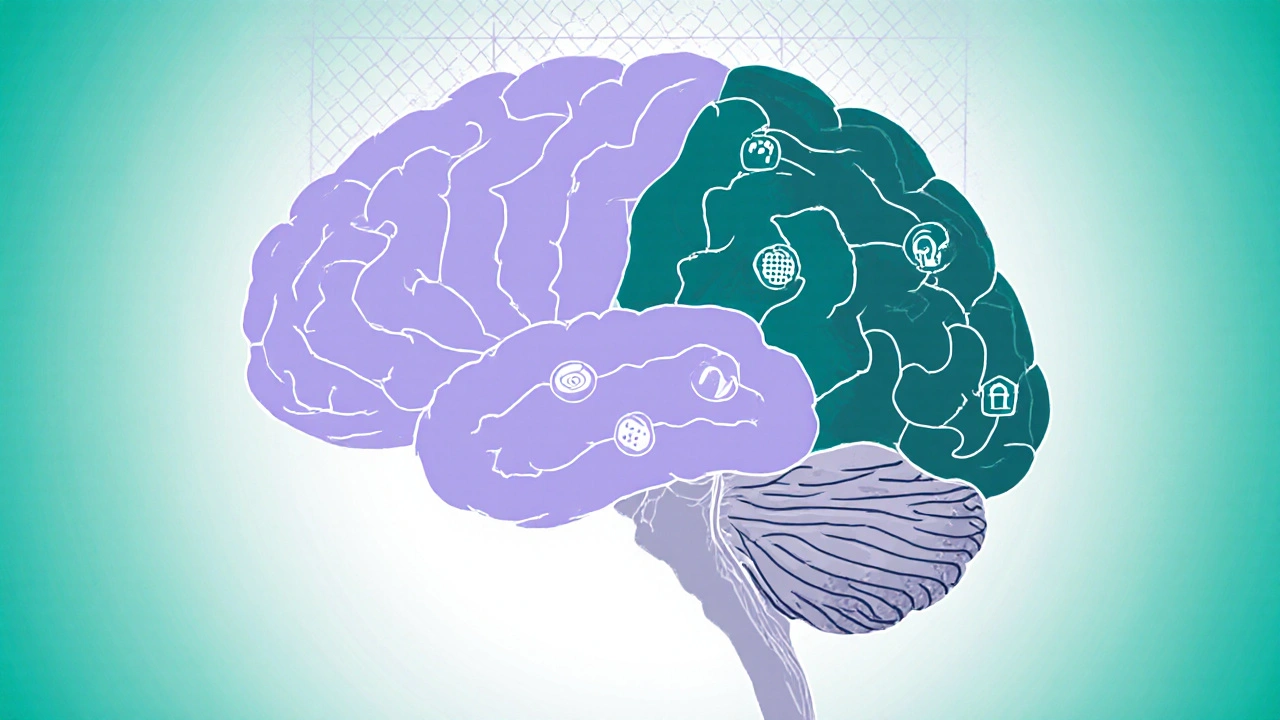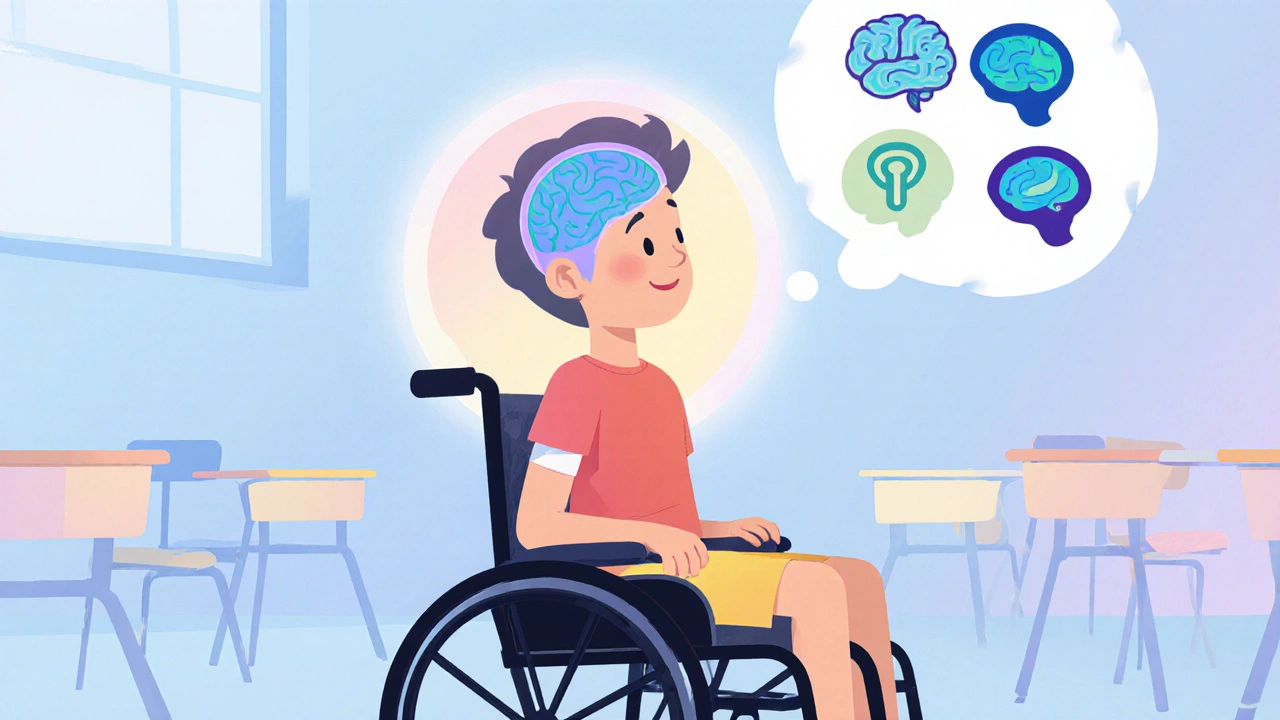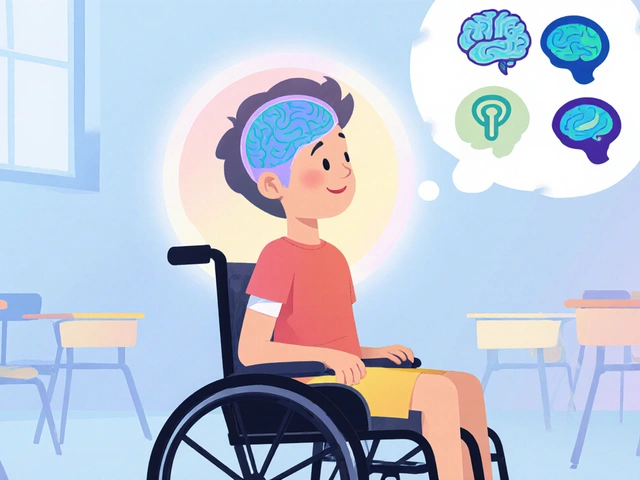DMD Cognitive Risk Assessment Tool
This tool estimates cognitive risk factors for boys with Duchenne Muscular Dystrophy based on key clinical factors. It's not a diagnostic tool but helps identify areas for further evaluation.
When you first hear about Duchenne muscular dystrophy, the image that comes to mind is usually muscle weakness and early loss of mobility. But there’s another side that families and clinicians often overlook: the way the disease changes the way the brain works.
What is Duchenne Muscular Dystrophy?
Duchenne Muscular Dystrophy is a rare, X‑linked recessive disorder caused by mutations in the dystrophin gene (DMD). The gene sits on the X chromosome, so boys are almost always affected while girls are typically carriers. Without functional dystrophin, muscle fibers break down, leading to progressive weakness that usually appears before age five.
Historically, treatments focused on slowing muscle loss-corticosteroids, physiotherapy, and orthopedic surgery. In the last decade, gene‑targeted therapies have reshaped the prognosis for mobility, yet neurologic outcomes lag behind.
Why Cognitive Function Matters in DMD
About one‑third of boys with DMD show below‑average IQ scores, and up to 70% experience specific learning difficulties. These deficits influence school performance, social integration, and ultimately quality of life. Parents often report that school‑related stress outweighs the physical challenges during early adolescence.
Understanding the cognitive profile helps clinicians tailor interventions-whether it’s speech‑language therapy, occupational support, or medication for attention problems.
The Science: How DMD Impacts the Brain
Two main mechanisms explain the neurocognitive impact:
- Dystrophin in the central nervous system: The same protein that stabilizes muscle membranes also appears in certain brain regions-particularly the cerebral cortex, hippocampus, and cerebellum. When dystrophin is missing, synaptic signaling becomes less efficient, which can impair memory formation and executive processing.
- Secondary vascular and metabolic effects: Chronic inflammation and steroid use can alter cerebral blood flow, and long‑term immobility may reduce neurotrophic factors essential for brain development.
Neuroimaging studies using MRI have consistently shown reduced gray‑matter volume in the frontal lobes of DMD patients, correlating with poorer scores on executive‑function tests.
Typical Cognitive Issues Observed
- Cognitive Function deficits often manifest as lower full‑scale IQ (average 85‑90) compared with the population mean of 100.
- Challenges with attention span and impulsivity, resembling Attention‑Deficit/Hyperactivity Disorder (ADHD) symptoms.
- Weaknesses in working memory and processing speed, making timed exams especially tough.
- Difficulty with abstract reasoning and planning-core components of executive function.
- Language delays, particularly in expressive vocabulary, which can affect social interactions.
It’s important to note that these issues are highly variable. Some boys perform within the average range and excel academically, while others need intensive support.

How Clinicians Assess Cognition in DMD
Standardized testing remains the cornerstone. The most commonly used batteries include:
- Wechsler Intelligence Scale for Children (WISC‑V) - provides Full‑Scale IQ, Verbal Comprehension, and Working Memory indices.
- Conners’ Rating Scales - screens for ADHD‑like behaviors.
- Behavior Rating Inventory of Executive Function (BRIEF) - evaluates planning, organization, and self‑monitoring.
- Neuropsychological assessments for language (CELF‑5) and academic achievement (WJ‑III).
Because motor limitations can interfere with test administration, many centers use adaptive devices or oral response formats. Early screening-ideally by age six-helps catch problems before they snowball.
Factors Influencing Cognitive Severity
Research points to several predictors:
- X‑linked inheritance patterns: Certain mutation hotspots (e.g., deletions affecting exons 45‑55) are linked with more pronounced neurocognitive deficits.
- Age of diagnosis: Earlier identification allows earlier intervention, which can mitigate learning gaps.
- Steroid regimen: While glucocorticoids improve muscle outcomes, high‑dose, long‑term use may exacerbate mood swings and attention issues.
- Socio‑economic status and access to specialized educational services.
Even within the same family, siblings with identical mutations can show different cognitive profiles, underscoring the role of environment and individual brain plasticity.
Practical Strategies & Interventions
Once a deficit is identified, a multidisciplinary plan is essential.
- Educational accommodations: Individualized Education Programs (IEPs) that allow extra time, preferential seating, and assistive technology (speech‑to‑text apps, audiobooks).
- Behavioral therapy: Cognitive‑behavioral techniques help manage anxiety and improve focus.
- Pharmacologic options: Stimulants (e.g., methylphenidate) are effective for ADHD‑like symptoms, but dosing must consider cardiac status.
- Physical activity: Low‑impact aerobic exercise promotes cerebral blood flow and may boost executive function.
- Family education: Training parents on how to structure homework, use visual schedules, and reinforce positive behaviors.
Regular re‑evaluation-every 1‑2 years-ensures the plan evolves with the child’s changing needs.

Emerging Research and Future Directions
Gene‑targeted therapies are the most exciting frontier. While exon‑skipping drugs (e.g., eteplirsen) restore some dystrophin in muscle, early animal studies suggest they also cross the blood‑brain barrier and improve neuronal signaling.
Clinical trials combining gene therapy vectors with neuroprotective agents are underway. Researchers are also investigating:
- CRISPR‑based editing to correct the mutation directly in brain tissue.
- Advanced MRI techniques (diffusion tensor imaging) to track white‑matter integrity over time.
- Neurotrophic factor supplements (e.g., BDNF mimetics) to support synaptic health.
If these approaches succeed, we could see a generation of boys with DMD who not only walk farther but also think clearer.
Quick Checklist for Parents and Caregivers
- Schedule a baseline neuropsychological evaluation by age 6.
- Request an IEP that addresses attention, processing speed, and executive function.
- Monitor steroid side‑effects-especially mood and sleep patterns.
- Stay informed about clinical trials targeting brain health.
- Connect with local DMD support groups for shared resources and advocacy.
Frequently Asked Questions
Do all boys with Duchenne muscular dystrophy have learning disabilities?
No. While roughly 30‑40% show below‑average IQ and many face specific learning challenges, a sizable minority score within the normal range and perform well academically. The variability depends on genetics, environment, and early intervention.
Can steroids worsen cognitive problems?
Steroids improve muscle strength but can have side‑effects like mood swings, sleep disturbances, and occasional attention issues. The net impact on cognition varies; doctors usually weigh benefits against potential neuro‑behavioral risks.
Is there a test that predicts cognitive outcome based on the DMD mutation?
Certain mutation hotspots (e.g., deletions affecting exons 45‑55) have been linked to lower IQ scores, but no single genetic test can definitively predict cognitive performance. Comprehensive neuropsychological assessment remains the gold standard.
What school accommodations work best for children with DMD?
Accommodations that address processing speed and stamina are most effective: extended test time, breaks during long tasks, audiobooks or text‑to‑speech software, and preferential seating to reduce visual distraction.
Are there any promising therapies aimed at brain health?
Early-phase trials of exon‑skipping drugs that cross the blood‑brain barrier have shown modest improvements in neurocognitive test scores. Researchers are also exploring CRISPR‑based brain editing and neurotrophic factor supplements, but these are still experimental.
Table: Cognitive Test Scores - DMD vs General Population
| Test | DMD (n≈120) | General Population (n≈200) |
|---|---|---|
| Full‑Scale IQ (WISC‑V) | 88 ± 12 | 100 ± 15 |
| Processing Speed Index | 84 ± 13 | 99 ± 14 |
| Working Memory Index | 86 ± 11 | 101 ± 13 |
| BRIEF Global Executive Composite | 68 ± 9 (higher = worse) | 50 ± 5 |
| Conners’ ADHD Rating Scale | 62 ± 8 (clinical range) | 45 ± 6 |
These numbers illustrate the typical gap but also a wide spread-some youths score well within normal limits, while others fall into the clinical range. Tailored support makes the difference.
Understanding how Duchenne muscular dystrophy reaches beyond muscles unlocks a more complete care plan. By screening early, using evidence‑based interventions, and staying tuned to emerging therapies, families can give their children the best shot at both mobility and mental success.



Penny Reeves
October 19, 2025 AT 20:08The neurocognitive profile in DMD is often romanticized in popular discourse; the primary literature, however, underscores a substantial heterogeneity that you scarcely acknowledge. Moreover, the emphasis on IQ deficits neglects the nuanced executive‑function impairments that truly disrupt daily living. While you list several interventions, the hierarchy of evidence remains vague, and the reader is left guessing which approach carries the most empirical weight. In short, the piece would benefit from a sharper critical lens and more precise citations.
Sunil Yathakula
October 27, 2025 AT 22:34Hey, great job summarizing a tough topic. Gonna say early screening really helps, so kudos for covering that!
Catherine Viola
November 5, 2025 AT 01:59Allow me to articulate a concern that appears to be omitted from the otherwise comprehensive discussion. One cannot disregard the possibility that certain pharmaceutical entities have, through strategic lobbying, influenced the dissemination of data pertaining to steroid‑induced cognitive side effects. The literature frequently employs euphemistic language, thereby obfuscating potential adverse outcomes. It is incumbent upon us, as discerning scholars, to interrogate such omissions with a rigor befitting an academic inquiry. Consequently, a more circumspect appraisal of the evidence base is warranted.
sravya rudraraju
November 13, 2025 AT 05:25I appreciate the effort to highlight cognitive aspects of Duchenne, yet the discussion would benefit from a more systematic presentation of the evidence.
First, longitudinal data indicate that early neuropsychological screening, ideally before age six, correlates with improved academic trajectories.
Second, the heterogeneity of dystrophin isoform expression in the brain suggests that genotype–phenotype mappings are far from deterministic.
Third, the impact of chronic glucocorticoid therapy on mood and executive function warrants a nuanced risk–benefit analysis.
Fourth, multimodal interventions-ranging from computerized working‑memory training to structured physical activity-have demonstrated modest gains in processing speed.
Moreover, technology‑assisted accommodations, such as text‑to‑speech and adaptive keyboards, alleviate the motor constraints that often confound test performance.
It is also crucial to involve interdisciplinary teams, including neuropsychologists, speech‑language pathologists, and educational specialists, from the onset of care.
Parental education programs empower families to implement consistent routines that reinforce attention and self‑regulation at home.
Evidence from recent randomized controlled trials suggests that stimulant medication, when carefully titrated, can ameliorate ADHD‑like symptoms without exacerbating cardiac risk.
However, clinicians must remain vigilant for potential side effects, such as sleep disturbances, that could indirectly impair cognition.
Neuroimaging biomarkers, particularly diffusion tensor imaging, are emerging as valuable tools to monitor white‑matter integrity over time.
These biomarkers may eventually guide personalized therapeutic decisions, aligning pharmacologic and behavioral strategies with individual neurodevelopmental trajectories.
Finally, ongoing participation in clinical trials exploring exon‑skipping agents that cross the blood‑brain barrier holds promise for addressing the root molecular deficit.
While the translational timeline remains uncertain, early-phase data are encouraging, showing modest improvements in executive‑function test scores.
In summary, a proactive, evidence‑based, and multidisciplinary approach is essential to maximize both motor and cognitive outcomes for boys with DMD.
Ben Bathgate
November 21, 2025 AT 08:51Nice post, but you missed the point.
Ankitpgujjar Poswal
November 29, 2025 AT 12:16Yo, that was shallow. You gotta dig deeper into how steroids actually mess with the brain, not just brush it off. Let’s get real about the side‑effects!
Christopher Burczyk
December 7, 2025 AT 15:42The review correctly identifies the primary neuropsychological deficits associated with DMD, yet it overlooks recent meta‑analytic findings that quantify the effect size of executive‑function impairments. In addition, the discussion on genotype–phenotype correlations could be expanded to include the newer data on Dp71 isoform expression. Overall, the article would be strengthened by integrating these contemporary sources.
Caroline Keller
December 15, 2025 AT 19:08Wow this is sooo heartbreaking the lack of info is just infuriating